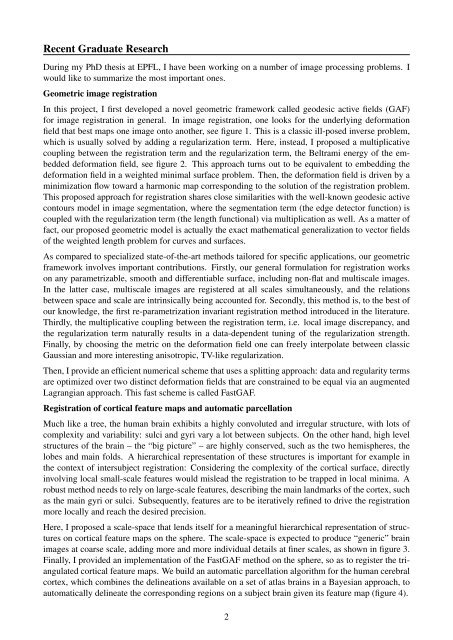Research statement - UCLA Department of Mathematics
Research statement - UCLA Department of Mathematics
Research statement - UCLA Department of Mathematics
Create successful ePaper yourself
Turn your PDF publications into a flip-book with our unique Google optimized e-Paper software.
Recent Graduate <strong>Research</strong><br />
During my PhD thesis at EPFL, I have been working on a number <strong>of</strong> image processing problems. I<br />
would like to summarize the most important ones.<br />
Geometric image registration<br />
In this project, I first developed a novel geometric framework called geodesic active fields (GAF)<br />
for image registration in general. In image registration, one looks for the underlying deformation<br />
field that best maps one image onto another, see figure 1. This is a classic ill-posed inverse problem,<br />
which is usually solved by adding a regularization term. Here, instead, I proposed a multiplicative<br />
coupling between the registration term and the regularization term, the Beltrami energy <strong>of</strong> the embedded<br />
deformation field, see figure 2. This approach turns out to be equivalent to embedding the<br />
deformation field in a weighted minimal surface problem. Then, the deformation field is driven by a<br />
minimization flow toward a harmonic map corresponding to the solution <strong>of</strong> the registration problem.<br />
This proposed approach for registration shares close similarities with the well-known geodesic active<br />
contours model in image segmentation, where the segmentation term (the edge detector function) is<br />
coupled with the regularization term (the length functional) via multiplication as well. As a matter <strong>of</strong><br />
fact, our proposed geometric model is actually the exact mathematical generalization to vector fields<br />
<strong>of</strong> the weighted length problem for curves and surfaces.<br />
As compared to specialized state-<strong>of</strong>-the-art methods tailored for specific applications, our geometric<br />
framework involves important contributions. Firstly, our general formulation for registration works<br />
on any parametrizable, smooth and differentiable surface, including non-flat and multiscale images.<br />
In the latter case, multiscale images are registered at all scales simultaneously, and the relations<br />
between space and scale are intrinsically being accounted for. Secondly, this method is, to the best <strong>of</strong><br />
our knowledge, the first re-parametrization invariant registration method introduced in the literature.<br />
Thirdly, the multiplicative coupling between the registration term, i.e. local image discrepancy, and<br />
the regularization term naturally results in a data-dependent tuning <strong>of</strong> the regularization strength.<br />
Finally, by choosing the metric on the deformation field one can freely interpolate between classic<br />
Gaussian and more interesting anisotropic, TV-like regularization.<br />
Then, I provide an efficient numerical scheme that uses a splitting approach: data and regularity terms<br />
are optimized over two distinct deformation fields that are constrained to be equal via an augmented<br />
Lagrangian approach. This fast scheme is called FastGAF.<br />
Registration <strong>of</strong> cortical feature maps and automatic parcellation<br />
Much like a tree, the human brain exhibits a highly convoluted and irregular structure, with lots <strong>of</strong><br />
complexity and variability: sulci and gyri vary a lot between subjects. On the other hand, high level<br />
structures <strong>of</strong> the brain – the “big picture” – are highly conserved, such as the two hemispheres, the<br />
lobes and main folds. A hierarchical representation <strong>of</strong> these structures is important for example in<br />
the context <strong>of</strong> intersubject registration: Considering the complexity <strong>of</strong> the cortical surface, directly<br />
involving local small-scale features would mislead the registration to be trapped in local minima. A<br />
robust method needs to rely on large-scale features, describing the main landmarks <strong>of</strong> the cortex, such<br />
as the main gyri or sulci. Subsequently, features are to be iteratively refined to drive the registration<br />
more locally and reach the desired precision.<br />
Here, I proposed a scale-space that lends itself for a meaningful hierarchical representation <strong>of</strong> structures<br />
on cortical feature maps on the sphere. The scale-space is expected to produce “generic” brain<br />
images at coarse scale, adding more and more individual details at finer scales, as shown in figure 3.<br />
Finally, I provided an implementation <strong>of</strong> the FastGAF method on the sphere, so as to register the triangulated<br />
cortical feature maps. We build an automatic parcellation algorithm for the human cerebral<br />
cortex, which combines the delineations available on a set <strong>of</strong> atlas brains in a Bayesian approach, to<br />
automatically delineate the corresponding regions on a subject brain given its feature map (figure 4).<br />
2
















